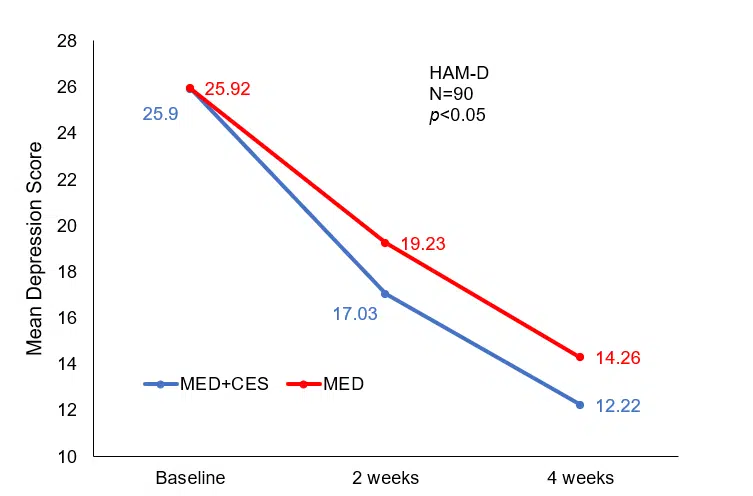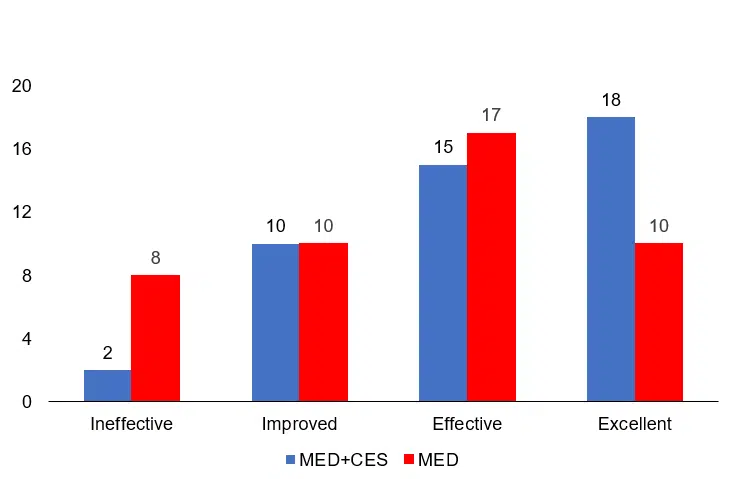Effect of CES Combined with Flupentixol-melitracen for Depression After Stroke
Liu, Y., Xie, L., Wang, L., Zhao, R-J., Xu F., & WANG, W-S. Effect of CES combined with flupentixol-melitracen for depression after stroke. Chinese Journal of Misdiagnosis. 16(2):106-109, 2021.
Funding Source, Location of Study or Author’s Affiliation
Department of Neurology, Xingtai People’s Hospital, Xingtai 054000, China
Device
Alpha-Stim®
Key Variables
Depression
Objective
To study the effect of cranial electrotherapy stimulation (CES) combined with flupentixol-melitracen for depression after stroke.
Design
A randomized controlled trial. Patients were randomly divided into two groups, a medication only control group (MED) and a medication combined with CES group (MED+CES).
Primary Outcome Measure
- Depression, as measured on the Hamilton Depression Rating scale (HAM-D), a 17-item item self-report measure. Items are scored 0-2 or 0-4. Score totalized are categorized as: normal (<7), possible depression (7-17), depression (17-24), and severe depression (>24).
Secondary Outcome Measure
- Treatment effect based on HAM-D score after treatment compared with before treatment. Reduction rate is divided into: Ineffective (<25%), Improved (25-49%), Effective (50-75), and Excellent (≥75%).
- Adverse reactions
Key Inclusion Criteria
- Stroke, confirmed by MRI and brain CT, conforming to the diagnostic criteria proposed at the Fourth National Cerebrovascular Disease Conference.
- Diagnosis of depression according to the Classification and Diagnostic Criteria of Mental Disorders in China.
- HAM-D score >17.
- No disturbance of consciousness and normal cognitive functioning.
Key Exclusion Criteria
- Glaucoma
- Hepatic and renal dysfunction
- Pregnant or lactating women
- Anaphylactic reaction to drugs used in the study
- Previous history of depression
Protocol Summary
A randomized cohort of two groups with a total of 45 patients each. The control group (MED) was treated with flupentixol-melitracen, including 10 mg melitracen and -.5 mg flupentixol in each tablet, once in the morning and once in the evening for 28 days. The experimental group (CES+MED) received the same medication dosage, plus CES treatment, for 28 days.
Device Application Protocol
The Alpha-Stim device was set to 1.5Hz and the current intensity was adjusted to 10-500 μA. The patient’s earlobe was cleaned before treatment, and the earclips were attached to the earlobe after applying a conducting solution. The current was increased until the patient felt a weak pinpricking sensation in the earlobes. The patient was advised to stay relaxed throughout the CES treatment process. The authors do not provide information regarding the length of each CES treatment.
Statistical Analysis Plan
The data was analyzed using SPSS 23.0 statistical software. The measurement data was expressed by () and tested by t. The enumeration data is expressed by (%) and tested by χ2. If p<0.05, the difference is statistically significant.
HAM-D measurements were taken before treatment, after two weeks of treatment, and after four weeks of treatment. HAM-D scores after treatment were compared to the before treatment scores. The deduction rate was divided into the following categories: Ineffective (<25%), Improved (25-49%), Effective (50-75), and Excellent (≥75%). Frequency of adverse reactions were recorded for each group.
Results
Subjects
A total of 90 patients with post-stroke depression admitted by the hospital from February 2018 to February 2020 were selected, randomly divided into two groups, 45 cases each. There were 25 males and 20 females in the study group, at the age of 43-76 years old, (56.6±6.9) years old on average, among which 22 patients suffered from right hemisphere lesion and 23 patients suffered from left hemisphere lesion. There were 24 males and 21 females in the control group, at the age of 44-78 years old, (57.1±6.8) years old on average, among which 20 patients suffered from right hemisphere lesion and 25 patients suffered from left hemisphere lesion. The comparative difference in general data of two groups had no statistical significance (p<0.05), but had comparability.
Data Analysis
HAM-D scores for the MED and MED+CES groups were not significantly different. The MED+CES had significantly lower scores on the HAM-D than the MED group after two weeks and four weeks (p<0.05), as indicated in the graph below.
Mean depression changes in the MED and MED+CES groups
Treatment effectiveness rates were significantly higher (p<0.05) for the MED+CES group (95.6%) at the end of four weeks than for the MED group (82.2%). The MED+CES group had only two participants report treatment was ineffective, compared to eight participants in the MED group. Additionally, 18 participants in the MED+CES group, compared to only 10 in the MED group, demonstrated excellent effectiveness based on HAM-D scores, as indicated in the chart below.
Treatment effectiveness after four weeks for MED+CES and MED groups
Adverse reactions were not significantly different between the two groups. The reported adverse reactions were mild and consistent with the side effects of flupentixol-melitracen.
| Group | Cases | Dizziness | Thirsty | Drowsiness | Constipation | Nausea | Adverse reaction rate (%) |
| CES+MED | 45 | 2 | 4 | 3 | 2 | 3 | 14 (31.1%) |
| MED | 45 | 3 | 4 | 3 | 3 | 3 | 16 (35.6%) |
| χ2 value | 0.562 | ||||||
| p value | >0.05 |
Types and rates of adverse reactions
Conclusion
Combining CES with a medication commonly prescribed for post-stroke depression significantly improved the treatment effectiveness over using the medication alone, without increasing the incidence or severity of adverse reactions.
Limitations
The authors did not follow the recommended treatment protocol for Alpha-Stim CES, using a frequency of 1.5 Hz rather than the recommended 0.5 Hz. Also, duration of treatment for each CES session was not specified, and the correct dosage for Alpha-Stim CES involves an interaction of current and time, with lower current intensities requiring longer treatment durations. The authors do not discuss an a priori plan for missing data, nor do they describe the randomization method used in the study.
Study Quality: FAIR


